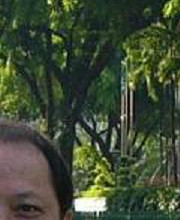| 图片: | |
|---|---|
| 名称: | |
| 描述: | |
- 请关注本专栏呈现的三个病人四个病例,很有趣(OFT-恶性OFT?!还是两个完全不同类型肿瘤?)
女性/67岁右前臂肿块 是 女性/60岁右前臂肿块 病人的7年后复发瘤 注意“菊形团
http://www.ipathology.cn/forum/forum_display.asp?keyno=229919
女性/60岁 右前臂肿瘤(与女性/67岁右前臂肿块是同一病人)
http://www.ipathology.cn/forum/forum_display.asp?keyno=229916
左侧腘窝肿瘤--这是一例真正经典型“恶性”,满足本肿瘤恶性的所有条件
http://www.ipathology.cn/forum/forum_display.asp?keyno=240465
腰部肿块--转自经典病例专栏
http://www.ipathology.cn/forum/forum_display.asp?keyno=233682
-
本帖最后由 于 2010-04-05 12:35:00 编辑

- 王军臣
-
本帖最后由 于 2010-04-07 03:43:00 编辑
感谢王主任组织讨论软组织OFT!
我提供的病例在第一届全国软组织和骨肿瘤临床病理研讨会上(2010-4-4)请大家讨论。
Dr. Alan和范钦和教授根据HE形态倾向诊断OFT、 复发瘤形态学异型程度增加。
王坚教授尚无诊断意见, 但指出本例CK强阳性,不支持OFT。
毛拥军主任(mrjys)诊断意见为:OFT。
此病人的详细病史为:
2003年首次手术前病程已有20年,肿瘤生长缓慢,无痛,近4年生长增快。
2003年手术后数月, 肿瘤复发,近年来出现明显的神经压迫症状。2010年第二次手术切除。
请大家针对1)OFT诊断;2)恶性OFT诊断标准;3)组织发生与软组织肌上皮瘤/混合瘤的鉴别诊断等问题进行广泛讨论、集思广议。特别是请有OFT病例的医师能提供IHC的标记结果。谢谢!

- xljin8
Am J Dermatopathol. 2007 Apr;29(2):156-9.
Cutaneous malignant ossifying fibromyxoid tumor.
Department of Pathology, Indiana University School of Medicine, Indianapolis, Indiana 46202-5126, USA.
Abstract
A 76-year-old woman presented with a well-circumscribed 3 cm mass of her right buttock. The tumor, partially surrounded by a shell of woven and lamellar bone, had a lobular arrangement of highly cellular islands of tumor cells embedded in a variably fibrous to myxoid stroma. The lesional cells had well defined cytoplasmic membranes with varying amounts of clear to lightly eosinophilic cytoplasm. The nuclei exhibited moderate to severe nuclear atypia. Areas of tumor necrosis were present. The mitotic rate was 17 MF/50 high-power fields. The tumor was diagnosed as an ossifying fibromyxoid tumor (OFMT). OFMT is a rare tumor first described in 1989. Although OFMT usually occurs in deep soft tissue, up to 11% of reported lesions presented as cutaneous tumors. OFMT usually present in adults on the extremities or trunk. Most are histologically bland and apparently benign tumors, but OFMT with high nuclear grade, high cellularity, and >2 MF/50 high-power fields have shown potential for aggressive behavior including metastasis. OFMT with these features should be considered sarcomas. Given the histologic features, this tumor was considered a malignant OFMT. The patient had a wide excision. The patient died secondary to unrelated comorbidities without evidence of recurrence or metastasis.

- 王军臣
Ultrastruct Pathol. 2005 Nov-Dec;29(6):535-48.
Ossifying fibromyxoid tumor: modified myoepithelial cell tumor? Report of three cases with immunohistochemical and electron microscopic studies.
Department of Pathology, Deaconess Hospital, Oklahoma City, Oklahoma 73112, USA. kmin@deaconessokc.org
Abstract
Ossifying fibromyxoid tumors (OFMT) are rare soft tissue tumors of uncertain histogenesis and clinical behavior. Since Enzinger, Weiss, and Liang first described 59 examples in 1989 (Am Surg Pathol. 13:817-827), approximately 150 cases have been reported. Their clinicopathologic features are fairly well characterized and their histogenesis remains unknown. Three examples of soft tissue tumors with typical histopathologic characteristics of OFMT were studied: case 1, a 43-year-old female with a 2.5-cm tumor of the back; case 2, a 56-year-old man with an 8-cm thigh mass; and case 3, an 81-year-old female with a 13.5-cm buttock tumor. For immunohistochemistry, formalin-fixed, paraffin-embedded tissue sections were stained with antibodies against cytokeratin, smooth muscle actin, desmin, vimentin, S-100 protein, EMA, and collagen type IV using standard ABC-peroxidase methods. For electron microscopy, tissue samples fixed in EM-grade buffered formalin were processed according to routine methods. Immunohistochemistry showed that the tumor cells were positive for vimentin and S-100 protein in all 3 cases. Stains for collagen type IV revealed diffusely positive staining in the stroma with a tendency for stronger staining around the cell borders in 2 out of 3 cases. Desmin was positive in one and actin was positive in one other case. By electron microscopy, tumor cells were characterized by centrally located round to oval nuclei with varying amounts of cytoplasm containing scanty cytoplasmic organelles. There were rare profiles of rough-surfaced endoplasmic reticulum (RER) and rare mitochondria with areas of condensed intermediate filaments. No tonofilaments or actin filaments were present. There were multiple short web-like processes, some of which were attached to that of neighboring cells by primitive cell junctions. In all 3 cases, lesional cells showed external lamina (EL), which was abundant in case 1, forming redundant scrolls frequently. In case 2, EL was less prominent and incomplete, and interrupted portions of EL were present only along the periphery of cell columns or nests bordering the stroma. In case 3, which behaved as a malignant tumor, the tumor cells were less differentiated spindle cells with primitive cellular features, and EL was rarely found along the short span of tumor cell borders. In this study, tumor cells in OFMT were polygonal to stellate often with multiple short cytoplasmic processes. The tumor cells were found to form cell clusters attached by primitive intercellular junctions between cytoplasmic processes forming intercellular bridges. The cell borders facing the stroma around cell clusters tended to be flat and had incomplete EL, while no EL was present along the cell borders facing the inner aspect of cell clusters. These ultrastructural findings together with immunophenotypic expression of S-100 protein presented closer resemblance to those of modified myoepithelial cells in pleomorphic adenomas of salivary glands and skin appendages rather than peripheral nerve sheath tumors. The authors conclude that these findings render more support to the hypothesis of myoepithelial histogenesis of OFMT. They also conclude that ultrastructural study not only helps accurate diagnosis, but also may aid in predicting malignant behavior by the degree of deviation from the typical examples of OFMT.

- 王军臣
Am J Surg Pathol. 2003 Apr;27(4):421-31.
Ossifying fibromyxoid tumor of soft parts: a clinicopathologic study of 70 cases with emphasis on atypical and malignant variants.
Department of Pathology H-175, Emory University Hospital, 1364 Clifton Road NE, Atlanta, GA 30322, USA. afolpe@emory.edu
Abstract
The ossifying fibromyxoid tumor of soft parts (OFMT) is an uncommon soft tissue neoplasm of uncertain lineage. Approximately 100 cases of OFMT have been reported. Although the majority behave in a benign fashion, very rare tumors with histologic and clinical evidence of malignancy have been reported. Criteria for malignancy in OFMT have not as yet been defined. Seventy cases of OFMT were retrieved from our consultation archives and studied with respect to patient age and sex, tumor site and size, growth pattern, percentage of typical OFMT, cellularity and nuclear grade, mitotic figures (MF)/50 high power fields (HPF), atypical mitoses, necrosis, vascular invasion, and the presence of bone. Immunohistochemistry for pancytokeratin, S-100 protein, smooth muscle actin, desmin, and collagen II was performed on a subset of cases. Follow-up information was obtained from the submitting pathologists and clinicians. The Fisher exact test was used for statistical analysis. Patients (39 male, 31 female) ranged in age from 14 to 83 years (median 49 years). The tumors occurred primarily as subcutaneous or deeply seated masses in the trunk and proximal extremities and ranged from 1 to 14 cm (median 4.0 cm). The percentage of typical OFMT present in each case ranged from 0% to 100% (median 70%), and bone was present in 44 cases (63%). Mitotic activity ranged from 0 to 40 MF/50 HPF (median 2 MF/50 HPF), necrosis was present in 12 cases (17%), and vascular invasion was seen in 8 cases (11%). High cellularity or high nuclear grade was seen in 14 and 13 cases, respectively. Immunohistochemical results were as follows: S-100 protein (33 of 55, 60%), pancytokeratin (5 of 48, 10%), smooth muscle actin (2 of 44, 5%), desmin (5 of 39, 13%), and collagen II (1 of 26, 4%). Follow-up (51 cases, mean 54 months, median 36 months, range 5-151 months) showed local recurrences in nine patients and metastases in eight patients. Currently, 41 patients are disease free, 6 are alive with disease, 4 are dead of disease, and 1 died of other causes. The presence of high cellularity (p = 0.002), high nuclear grade (p = 0.001), or >2 MF/50 HPF (p = 0.004) were significantly associated with the development of metastatic disease and local recurrence. Infiltrative growth was also associated with increased risk of local recurrence (p = 0.03). We conclude that the histologic spectrum of OFMT is broader than previously appreciated, as many clinically benign cases display moderate cellularity, nuclear enlargement, or have identifiable mitotic figures. Our results strongly suggest that OFMT with 1) high nuclear grade or 2) high cellularity and mitotic activity of >2 MF/50 HPF should be regarded as sarcomas with significant potential for metastasis and untoward outcome ("malignant OFMT"). The remainder can be considered within the spectrum of OFMT, recognizing that even these lesions possess a risk, albeit very low, of metastasis. Consequently, OFMT should be considered tumors of intermediate malignancy. Their line of differentiation remains unclear, although we suggest they may belong to the category of translocation-associated sarcomas, not all of which recapitulate a normal line of differentiation.

- 王军臣
Indian J Pathol Microbiol. 2001 Apr;44(2):163-7.
Nerve cell markers in ossifying fibromyxoid tumour of soft parts.
Shet T, Desai S, Kane S, Vora I.
Department of Pathology, BYL Nair Ch Hospital, Mumbai.
Abstract
Reported herein are two benign ossifying fibromyxoid tumors (OFMTs) of the soft tissues in axilla and terminal phalanx respectively. Both cases on immunohistochemistry (IHC) showed reactivity for vimentin, S-100 protein and glial fibrillary acidic protein (GFAP) antibodies. In addition, a focal/diffuse strong positivity for neurofilament (NF) and neuron specific enolase (NSE) was observed. Electron microscopy in one instance revealed abundant intermediate filaments, primitive cell junctions and a focally present external lamina. In the light of nerve cell differentiation of these tumors and the similarity of IHC profile and EM features of OFMT to a poorly differentiated malignant peripheral nerve sheath tumor (MPNST); it is suggested that OFMT is a variably differentiated PNST rather than a simple Schwannian neoplasm as is believed.

- 王军臣
Ann Diagn Pathol. 1997 Dec;1(2):73-81.
Ossifying fibromyxoid tumor of soft parts: a report of 17 cases with emphasis on unusual histological features.
Zámecník M, Michal M, Simpson RH, Lamovec J, Hlavcák P, Kinkor Z, Mukensnábl P, Matĕjovský Z, Betlach J.
Department of Pathology, Postgraduate Medical School, Bratislava, Slovak Republic.
Abstract
Ossifying fibromyxoid tumor of soft parts is an unusual benign neoplasm, with a tendency for local recurrence. Its typical microscopic appearance is that of a multinodular proliferation of round to spindle shaped cells separated by fibrous bands in which bone formation is often seen. Herein, we present the clinicopathologic features of 17 examples of this tumor with particular emphasis on some unusual histopathologic features that may place pitfalls in the diagnosis of this tumor, including satellite micronodules, mucinous microcysts, absence of myxoid areas, crush artifact, multiple microcalcifications, epidermoid cysts, atypical chondroid differentiation with binucleate lacunar cells, pericytic growth pattern, and malignant change. Awareness of these unusual morphologic features should lead to a search for areas displaying the more typical features of ossifying fibromyxoid tumor to arrive at a correct diagnosis.

- 王军臣
Am J Surg Pathol. 1995 Sep;19(9):1039-46.
Atypical and malignant variants of ossifying fibromyxoid tumor. Clinicopathologic analysis of six cases.
Kilpatrick SE, Ward WG, Mozes M, Miettinen M, Fukunaga M, Fletcher CD.
Department of Pathology, North Carolina Baptist Hospital, Bowman Gray School of Medicine, Winston-Salem, USA.
Abstract
Ossifying fibromyxoid tumor (OFMT) of soft parts is a recently defined fibro-osseous neoplasm, the biologic behavior of which is generally regarded as benign. We report six variant cases of OFMT with histologic features of malignancy, two of which behaved aggressively. All these tumors arose in the extremities of adults (aged 36-76 years), and five of the six were subcutaneous. Four patients were men. Macroscopically, all the tumors were well circumscribed and somewhat lobulated. Cardinal morphologic features included lobules of round to spindled cells within a fibromyxoid matrix and randomly distributed, often centrally located osteoid within which were plump neoplastic cells. In contrast to typical OFMT, a hypocellular, cytologically benign, lamellar bony shell was observed only focally; cellularity was increased (four cases), and mitotic activity was frequent, exceeding two mitotic figures per 10 high-power fields (three cases). One case associated with metastases was morphologically bland. Immunohistochemically, positivity for S-100 protein was observed in the primary tumors of three cases and in the pulmonary metastasis of a fourth. Desmin was positive in one case. Ultrastructural features in three cases were very similar to usual OFMT. Clinical follow-up revealed local recurrence in two cases; one patient has developed recurrent pulmonary metastases. We believe these findings support the view that some atypical cases of OFMT exhibit morphologic patterns that might predict more aggressive behavior.

- 王军臣
Skeletal Radiol. 1991;20(8):608-12.
Case report 685: Ossifying fibromyxoid tumor of the soft parts of the upper arm.
Akai M, Azuma H, Ohno T, Kimura H, Sugano I, Nagao K.
Department of Orthopaedics, Saitama Medical School, Japan.
Abstract
We report an unusual case of an ossifying tumor arising in the deep soft tissue adjacent to the humerus of a 72-year-old woman. The tumor exhibited sarcoma-like features histologically, although its clinical course unexpectedly differed from that of a malignant tumor. We diagnosed this particular case as an ossifying fibromyxoid tumor of soft parts, which has been recently described by Enzinger et al.. This is another example of an ossifying soft-tissue tumor which simulates a malignant sarcoma.

- 王军臣
Ann Thorac Surg. 2006 Jun;81(6):2289-91.
Mediastinal and pulmonary metastases of malignant ossifying fibromyxoid tumor.
Suehiro K, Pritzwald-Stegmann P, Lee KM, Teoh HH, Alison PM.
Cardiothoracic Surgical Unit, Auckland City Hospital, Auckland, New Zealand.
Abstract
Ossifying fibromyxoid tumor is usually a benign tumor. However some of these tumors with histologic and clinical evidence of malignancy have also been reported and little information is available regarding surgery for metastatic ossifying fibromyxoid tumor. We present a case involving extensive excision of a huge metastatic ossifying fibromyxoid tumor occupying the upper mediastinum and upper half of the right hemithorax.

- 王军臣
-
本帖最后由 于 2010-04-08 22:38:00 编辑
免疫组化显示OFT肿瘤细胞波形蛋白(vimentin)和 s-100 蛋白均为阳性。 IV型胶原在基质中尤其是围绕细胞周围呈弥漫强阳性染色。 结蛋白(desmin)和肌动蛋白(actin)有的可以呈阳性。 瘤细胞呈多边形或星状,富于胞质短突。肿瘤细胞经由其初级短突起形成桥接构成细胞簇团。电镜(主要是恶性的):肿瘤细胞胞核位于细胞中央,圆形或卵圆形;胞质多少不等,细胞器较少。在中间丝致密的区域,粗面内质网 (RER) 和线粒体很少见。 未见张力微丝或肌动蛋白丝。 细胞有多个短突起与相邻细胞的初级突起接触连成网状。瘤细胞有细胞外板 (EL)围绕其周围, 有的细胞外板不明显或不完整。在细胞簇团内侧边缘缺乏外板结构。这些超微结构特征结合 s-100 蛋白的免疫表型,提示其类似于涎腺和皮肤附件腺瘤中的肌上皮细胞样变异的表型,而不像外周神经鞘膜瘤的表型。 所以,有作者提出OFT 源自肌上皮组织发生的假设。 他们也发觉超微结构的研究不仅有助于准确地诊断,但也可有助于预测由经典型OFT演变为恶性行为OFT的趋势。
Ultrastruct Pathol. 2005 Nov-Dec;29(6):535-48

- 王军臣
关于OFT起源和或分类的另类观点:
有作者对OFT作免疫组织化学 (IHC)显示,OFT表达vimentin、 S-100 蛋白和胶质纤维酸性蛋白 (GFAP) 呈阳性反应。 此外, /神经丝 (NF) 和神经元烯醇化酶 (NSE)呈局灶或弥漫强阳性表达。电镜观察发现肿瘤细胞含有丰富的中间丝、 有初级细胞连接,局灶细胞外板。 这些结果提示,OFT呈神经分化趋势,其IHC 表达谱和电镜特征与恶性外周神经鞘膜瘤 (MPNST)相似。所以认为 ,OFT 不是曾经设想的那样一个简单的神经鞘瘤,而可能是一个分化变异的 PNST之类的肿瘤。
Indian J Pathol Microbiol. 2001 Apr;44(2):163-7.

- 王军臣
-
wangdingding 离线
- 帖子:1474
- 粉蓝豆:98
- 经验:6042
- 注册时间:2006-10-19
- 加关注 | 发消息



















